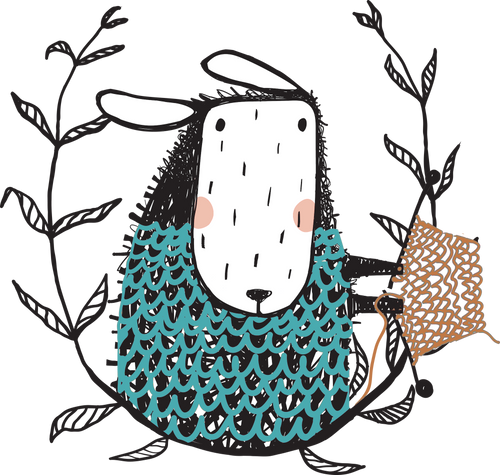The Ringalina Doll Head
Now, let's finally get some hands-on experience!
Right now you have to make the decision if you would like to make a 17"-18" tall doll or a 15"-16" tall doll. The taller one has a head circumference of about 13"-14" and the shorter one about 11"-12". We will be rolling a wool ball, shape the head and a basic sculpting of the face.
We will be rolling a wool ball, shape the head and a basic sculpting of the face.
Please, note that we roll a ball of 2" larger than the head circumference we want to end up with. So at least 15" for the taller or 13" for the shorter Ringalina Doll. Rather opt on the larger side, unless you are a tight wool roller.
We created a ball that we turned into "the brain" for our doll. Now we will continue and cover it with layers upon layers of wool and adding tube gauze to shape it.
You will need the following stitches:
-double wrap-knot
-the basic whip stitch
We completed the shaping of the head and are now ready to sculpt. This part is one of my favorite parts in doll making, as this is the moment when (I believe) my doll will receive his or her character.
You will need to know the following stitches:
-cross stitch in place
-ladder/invisible stitch
The eye string like the equator between "north" and "south" pole (top of head and neck). Please be sure it is centered, don't let the grain of the fabric trick you.
- rolled to circumference of 14 inches
- 14" circumference shrunk down to 12"

- after layers and tube gauze are added
- eye-string
- pinning to mark ears
- ear mark - cross stitching
- lowering eye-string in the back
- hiding string with invisible stitch
- frontal of basic head
The eye-string runs like the equator between "north" and "south" pole (top of head and neck). Please be sure it is centered, don't let the grain of the fabric trick you. I am posting a frontal view and a side view here, because that isn't shown long enough in the video.
Thanks to Nancy who pointed out that the video isn't clear enough I am adding some pictures below.
The eye-string runs like the equator between "north" and "south" pole (top of head and neck). Please be sure it is centered, don't let the grain of the fabric trick you. I am posting a frontal view (first image) and a side view (second image) here, because that isn't shown long enough in the video. The side view shows also where the cross stitch in place secures the eye-string very well.
You are at the point where you created the basic head for your Waldorf doll and have options.... You can now add skin fabric for the basic doll, add another tie to increase the sculpting, or even adding needle felted features. Take a look at the videos coming up before you make your final decision.
We will be using all of the stitches:
-the running/basting stitch
-the back-stitch
-the whipstitch
-the ladder/invisible stitch.
- Added chin thread
The cheeks are added by adding another string, which gets pulled through the head from ear to ear, under the chin and back to the ear. Repeat and pull tight 5-7 times. Below you see 2 close up pictures of the added cheeks
 Frontal View
Frontal View

- frontal needle felted face

- Below I am showing the needle felted face where the eyes will be embroidered. The lips are felted and a red beeswax crayon is used after the skin fabric is added to color them a little. I am still new to adding needle felted lips, but thought I'd show how it could be done.
- frontal felted face with lips
- side view of felted face with lips
- particular doll that goes with the images of felted face















